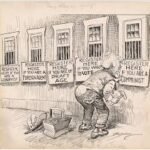Letters Written on Poison in Cartoons If you’ve watched even a handful of classic cartoons, you’ve probably seen it—a bottle with dark liquid bubbling ominously, a skull and crossbones etched on the side, and in big, bold letters: POISON. Cartoons have always thrived on exaggeration, and when it comes to danger, there’s no subtler symbol than a bottle loudly proclaiming its deadly nature. But why is the word “POISON” always written in all caps? Why is it so visually exaggerated? And how did it become a trope so deeply rooted in the world of animation? Let’s take a closer (but not too close!) look at this animated danger sign.
The History of Poison Labels in Animation
The use of poison labels in cartoons dates back to the early 20th century, influenced heavily by real-world product labeling laws. As regulations required dangerous substances to be clearly marked, animators adopted and exaggerated those warnings for dramatic (and comedic) effect.
Shows like Merrie Melodies and Looney Tunes used these labels as visual shorthand: when you saw the word “POISON,” you instantly knew something chaotic or hilarious was about to happen.
The Bold Typography of “POISON”
The Typical Fonts Used
Cartoon poison labels usually feature thick, serif fonts, often reminiscent of vintage Western typography. Sometimes they’re hand-drawn with uneven edges to give them a more “dangerous” or dramatic flair.
Capital Letters and Exaggeration
The word POISON is always written in capital letters—because subtlety just doesn’t work in slapstick animation. It screams danger, much like a neon sign flashing “STAY AWAY.”
Why Readability is Key
Quick, visual readability is vital in cartoons. Animators have milliseconds to get the message across. A giant, all-caps “POISON” label removes any doubt about the bottle’s contents.
Iconography Alongside the Word
Skull and Crossbones Symbol
Often placed right above or beside the word “POISON,” this symbol instantly conveys the idea of death or danger. Even kids who can’t read yet understand what it means.
Green Liquid and Bubbling Bottles
The liquid inside is usually bright green or purple, often bubbling or emitting smoke—visually reinforcing its lethal nature.
Smoke, Bubbles, and Visual Drama
To heighten the drama, poison is often depicted as sizzling, foaming, or glowing. It’s a cartoon, after all—why not make danger look cool?
Famous Cartoons Featuring Poison Labels
Looney Tunes
Wile E. Coyote’s ACME poison bottles are legendary. Often used in failed attempts to catch the Road Runner, these bottles are clearly labeled yet hilariously ineffective.
Tom and Jerry
Tom often ends up drinking his own poison trap—another classic case of slapstick backfiring.
The Simpsons
The show has used poison labels both for dark humor and plot points, like when Mr.
Scooby-Doo
Mysterious brews and clearly marked poison vials are often found in haunted houses and villain lairs.
Disney Villains
Snow White’s poisoned apple may not have a label, but in other Disney films like The Emperor’s New Groove, potions are labeled clearly—even if they’re “extract of llama.”
Comic Timing and Visual Gags
Poison is often used for its comedic potential. Think of a character pouring poison into a drink, only to drink it themselves seconds later. The gag usually ends with exaggerated coughing, a dramatic collapse, and a miraculous recovery—all for laughs.
This predictable cycle makes poison a favorite tool for cartoon writers: high stakes, low risk.
Poison as a Plot Device
Villain Tools
Many animated villains—think Gargamel from The Smurfs—use labeled poison to try and capture or eliminate heroes.
Mistaken Identity Plots
Hilarity (and panic) ensues.
Animal Antics and Reversals
Sometimes the intended victim outsmarts the poisoner—like Bugs Bunny switching glasses with Elmer Fudd at the last second.
Why the Word “POISON” is Always So Obvious
Cartoon Logic and Audience Clarity
Cartoons thrive on exaggeration and instant recognition. You don’t have time to guess what’s in a bottle—just slap a “POISON” label on it!
Safety in Storytelling
Labeling it clearly also helps young viewers understand that the substance is dangerous—important in a medium often watched by children.
Avoiding Real-World Confusion
By making poison over-the-top in cartoons, creators make it very clear: this is not real, it’s fiction. Kids are less likely to confuse cartoon bottles with real ones.
The Psychology of Poison Imagery
Poison bottles in cartoons represent forbidden danger—something you shouldn’t touch but are curious about. The bold label acts as both a warning and an invitation for chaos.
It’s the same psychology behind “Do Not Push This Button” signs—once you read it, you kind of want to.
Evolution of Poison Labels in Modern Cartoons
As animation has become more sophisticated, poison labels have evolved too.
-
Classic: “POISON” in big caps, with skull symbols
-
Modern: “TOXIC,” “HAZARD,” or even comical labels like “DO NOT DRINK”
-
Stylized: Glowing labels, animated effects, and digital overlays
Digital animation allows for more creative takes on poison bottles—like holograms or pulsing auras.
Cultural Significance of Poison in Cartoons
Across cultures, poison is universally recognized as a symbol of danger. The word “poison” itself, or its translation, is often used regardless of language barriers in global animation.
Even anime features similar cues—bright liquids, labeled flasks, and skull motifs—proving the universal visual language of danger.
How the Label “POISON” Became a Cartoon Trope
Like anvils, banana peels, and falling pianos, poison bottles labeled in bold letters have become a trope—a recurring symbol reused for humor or plot convenience.
Because the label is so familiar, animators don’t even need to explain it.
Parodies and Pop Culture References
Modern shows like SpongeBob, Rick and Morty, and Animaniacs often parody poison labels. Some even switch the text to humorous alternatives like:
-
“Definitely Not Poison”
-
“Drink Me (Trust Me)”
-
“Essence of Evil”
These twists keep the trope fresh and self-aware.
Conclusion
The bold, unmistakable “POISON” label is more than just text in a cartoon—it’s a visual shorthand packed with history, humor, and danger. Whether it’s in a bubbling flask held by a villain or a drink accidentally mixed up by the hero, that big-lettered warning tells us exactly what to expect: trouble, laughter, or both.
From the early days of animation to today’s digital spectacles, this simple word continues to play a vital role in cartoon storytelling. And while we know it’s fake, we also know to stay far away—unless, of course, it’s part of a perfectly timed gag.

